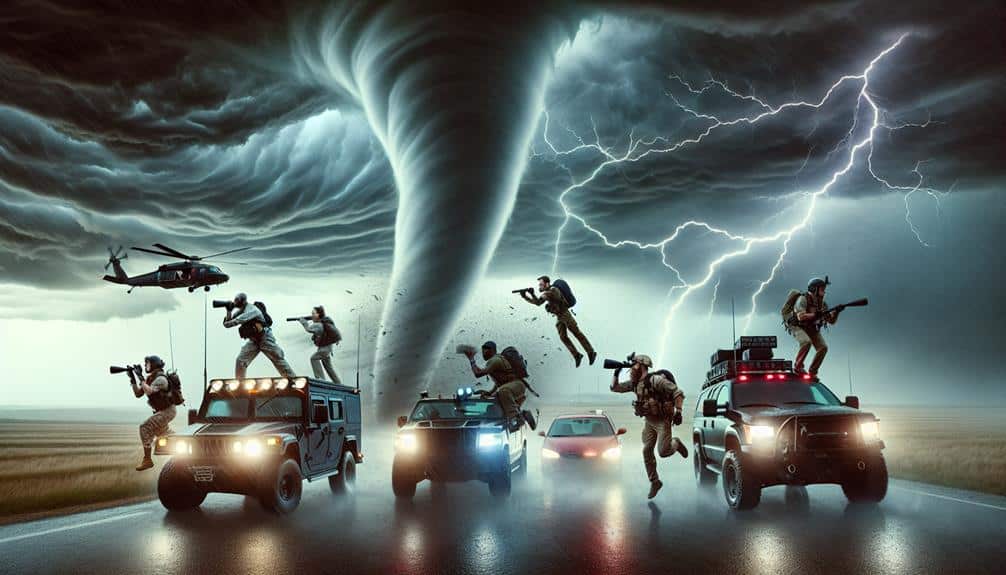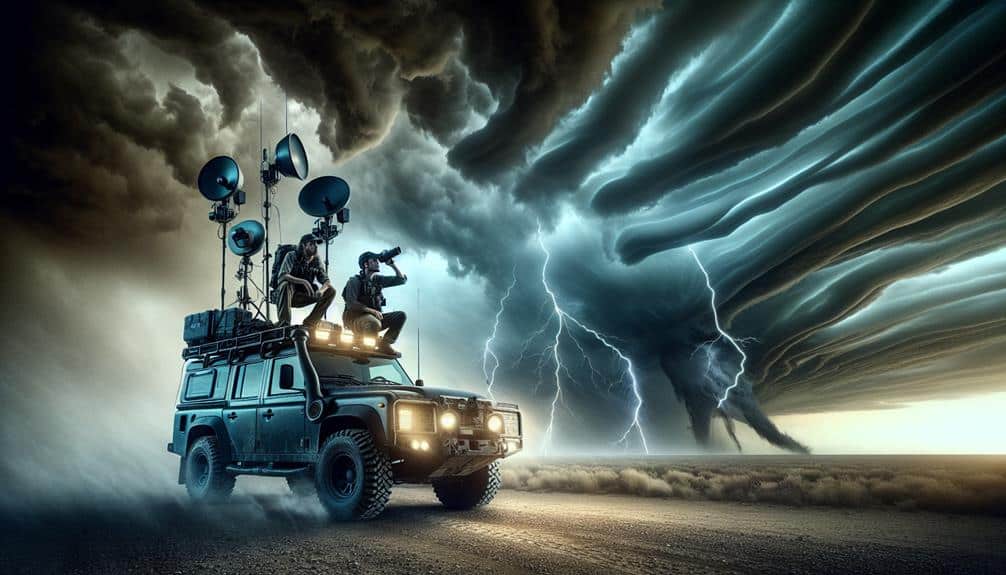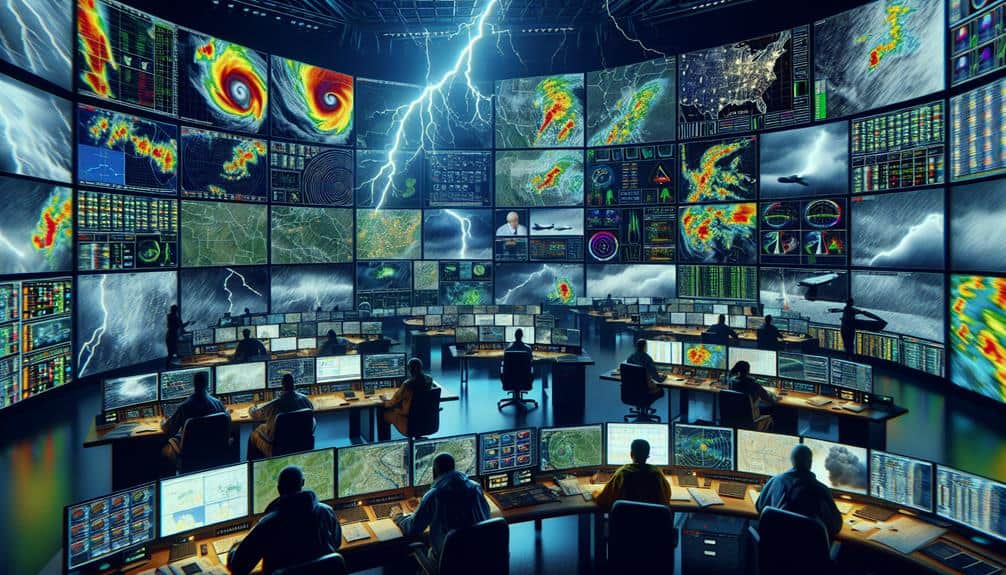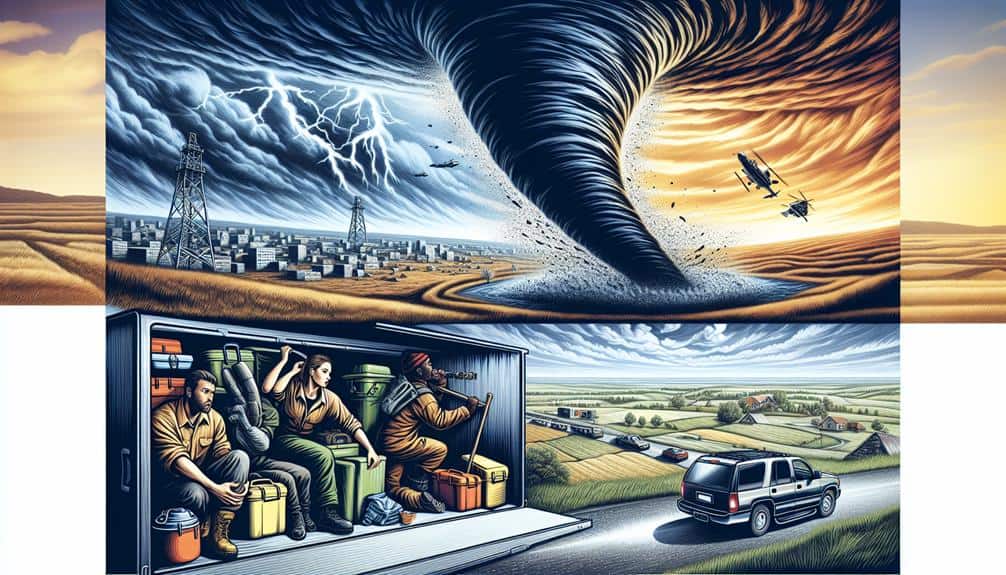Joining storm spotting teams enhances our storm chasing efforts significantly. We implement real-time weather monitoring, coordinate with emergency services, and utilize advanced tools like Doppler radar and satellite imagery. These teams provide networking opportunities with experienced meteorologists and fellow chasers, fostering skill development and teamwork. Access to up-to-the-minute data allows us to adjust our course instantly, ensuring safety and contributing to public safety through timely reports. By gathering precise data, we advance meteorological research and improve weather prediction models. Our collective efforts result in a higher success rate and deeper understanding of storm dynamics. Discover how you can benefit from joining us.
Key Points
- Enhanced safety through real-time weather monitoring and coordination with emergency services.
- Access to advanced tools like Doppler radar and high-resolution satellite imagery.
- Real-time weather updates for better storm tracking and public safety contributions.
- Networking with experts and fellow storm chasers, fostering a collaborative environment.
Enhanced Safety Measures
To ensure our safety while storm chasing, we implement rigorous protocols such as real-time weather monitoring and coordination with local emergency services.
Our emergency preparedness is of utmost importance. We've developed a detailed set of safety protocols to handle any situation that arises.
Continuous team communication is essential, ensuring everyone's aware of the latest updates and potential hazards.
We use risk mitigation strategies to minimize danger. For example, we avoid high-risk areas and maintain safe distances from severe weather phenomena.
Our team communication includes the use of radios, GPS systems, and mobile apps to relay real-time information. These tools allow us to adapt quickly, making informed decisions based on the latest data.
Coordination with local emergency services is another crucial aspect. By staying in touch with local authorities, we can receive timely alerts and updates, enhancing our situational awareness.
This collaboration ensures we're prepared for any sudden changes in weather conditions, and it allows us to assist in broader emergency response efforts if needed.
Access to Advanced Tools
Our storm chasing team leverages cutting-edge technology, including Doppler radar systems, high-resolution satellite imagery, and mobile weather stations, to enhance our predictive capabilities and decision-making processes. These tools allow us to analyze storm structures more accurately, predicting their movements and potential severity with greater precision.
We integrate this technology into our operations through rigorous training sessions. These sessions guarantee every team member can effectively use the advanced tools at our disposal. For instance, understanding the intricacies of Doppler radar data helps us identify rotation within a storm, a pivotal factor in predicting tornadoes.
Our collaborative efforts are amplified by tracking software that synthesizes data from multiple sources. This integrated approach allows us to cross-verify information, reducing uncertainties and enhancing our situational awareness. By working together and sharing real-time data, we can make informed decisions quickly, which is essential when dealing with rapidly changing weather conditions.
Moreover, technology integration isn't just about the gadgets; it's about how we use them collectively to maximize our effectiveness. Through dedicated training and seamless collaboration, we harness the full potential of these advanced tools, ensuring we stay ahead of the storm and maintain our freedom to explore safely.
Real-Time Weather Updates
Real-time weather updates are vital for storm chasers, providing us with the latest information on storm developments and helping us make timely, informed decisions. Utilizing sophisticated weather tracking systems, we can monitor shifts in storm intensity, trajectory, and potential risks. Advanced radar technology, satellite imagery, and mobile weather apps enable us to access up-to-the-minute data, ensuring we stay ahead of the storm.
The importance of real-time updates can't be overstressed. They allow us to adjust our course instantaneously, maximizing our safety while optimizing our observational opportunities. For example, Doppler radar helps us detect rotation within a storm, indicating the potential for tornado formation. This capability is critical for both our safety and the broader goal of emergency response.
In the midst of a storm, reliable data streams mean the difference between life and death. As storm spotters, our timely reports contribute to public safety, enabling authorities to issue warnings and prepare for potential emergencies. By integrating real-time updates into our decision-making process, we're empowered to act swiftly and responsibly.
This blend of science and action underscores why real-time weather updates are essential for storm chasing.
Networking Opportunities
By joining storm spotting teams, we gain invaluable networking opportunities that connect us with experienced meteorologists, fellow storm chasers, and emergency management professionals. These connections are crucial for our growth and effectiveness in the field. We benefit from the collective knowledge shared within these networks, enhancing our understanding of storm behavior and safety protocols.
Community building is a significant aspect of these teams. By working closely with a diverse group of individuals, we create a supportive environment where information and experiences are freely exchanged. This camaraderie not only makes storm chasing more enjoyable but also guarantees a higher level of operational efficiency and safety.
Professional connections established through these teams can open doors to career advancements and collaborative projects. For instance, insights from seasoned meteorologists can lead to better predictive models and more accurate storm tracking methods. Collaborating with emergency management professionals helps us understand the broader impact of our work, ensuring that our efforts contribute to public safety.
Skill Development

Developing our skills as storm spotters involves rigorous training in meteorological analysis, hazard recognition, and communication protocols. We engage in team collaboration, enhancing our ability to interpret weather patterns and identify potential threats. This collaborative environment isn't just essential; we gain hands-on experience through real-time storm tracking and data collection.
Under expert guidance, we undergo field training that sharpens our observational skills and decision-making processes. Experienced meteorologists and seasoned storm chasers provide invaluable insights, allowing us to learn from their vast knowledge. This mentorship is pivotal, as it helps us understand the intricacies of storm development and behavior.
Our training also includes practicing communication protocols essential for effective team operation. Accurate and timely information sharing can make a significant difference in safety and data accuracy. By working closely with our peers, we develop a cohesive unit capable of responding to rapidly changing weather conditions.
Field training offers us a sense of freedom and autonomy. We're not confined to classrooms; instead, we apply our skills directly in the environment we're studying. This blend of expert guidance and practical experience fosters a deep understanding of storm dynamics, preparing us for the unpredictable nature of storm chasing.
Contribution to Science
By joining storm spotting teams, we directly contribute to advancing meteorological research and enhancing weather prediction accuracy.
Our real-time data collection during storms provides critical information that helps scientists develop better forecasting models.
This work is essential for improving public safety and understanding severe weather patterns.
Advancing Meteorological Research
Storm spotting teams play a pivotal role in advancing meteorological research by providing critical, real-time data that enhances our understanding of severe weather phenomena.
As we chase storms, we collect invaluable information that feeds into data analysis. This data helps scientists identify patterns, improving forecast accuracy and deepening our knowledge of storm dynamics.
Our efforts directly contribute to scientific datasets that meteorologists rely on to study storm behavior. By capturing high-resolution data on wind speeds, precipitation, and atmospheric pressure, we provide the raw material needed for advanced modeling. This, in turn, allows researchers to develop more precise simulations and predictions.
Moreover, the data we gather often leads to new insights that challenge existing theories and push the boundaries of meteorological science. For example, our observations of tornado genesis and dissipation offer real-world evidence that can either support or refute current hypotheses. This iterative process of data collection and analysis is essential for scientific progress.
In essence, by joining storm spotting teams, we're not just thrill-seekers; we're contributors to a broader mission. Our work helps refine the scientific models that keep communities safer and more informed.
Enhancing Weather Prediction
Our real-time information not only advances meteorological research but also greatly enhances weather prediction models, allowing more precise and timely forecasts. By joining storm spotting teams, we provide vital information that directly influences improved forecasting.
When we observe and record storm behavior in real time, we offer meteorologists with detailed data that satellite and radar alone can't capture. This ground-level perspective is invaluable for refining models and increasing the precision in predictions.
Accurate and timely forecasts are crucial for public safety and preparedness. Our contributions help meteorologists issue more exact warnings, giving communities the time they need to take protective measures. For example, pinpointing the exact path of a tornado can save countless lives and reduce property damage.
The data we gather isn't just about immediate benefits; it feeds into long-term studies that enhance our understanding of storm dynamics, leading to continued improvements in forecasting technology.
In essence, our involvement in storm spotting and chasing builds a bridge between raw data and actionable insights. This collaboration guarantees that meteorological models aren't only based on theoretical data but also grounded in real-world observations, leading to unparalleled accuracy in weather predictions.
Data Collection Importance
Collecting data during storm spotting expeditions fundamentally advances our scientific understanding of severe weather phenomena. When we actively gather information from the field, we're contributing to critical research collaboration efforts that improve weather analysis.
These real-time observations are indispensable for validating and refining predictive models. For instance, the precise measurement of wind speeds, atmospheric pressure, and precipitation rates during a storm provides robust datasets that meteorologists and climate scientists can use to enhance forecast accuracy.
Additionally, our efforts in data collection have a direct impact on community engagement and public awareness. The data we collect isn't just for academic purposes; it also serves to inform local authorities and emergency services, enabling them to make timely, life-saving decisions. By sharing our findings, we help raise awareness about storm preparedness and safety measures within local communities.
Moreover, our work fosters a sense of unity and purpose among team members, reinforcing the importance of our mission. Each piece of data we collect forms part of a larger puzzle, contributing to a collective effort that spans across regions and disciplines.
In this way, our storm spotting expeditions not only advance science but also serve the greater good.
Increased Chase Success

Teaming up with experienced storm spotters greatly enhances our chances of successfully tracking and analyzing severe weather events. By leveraging improved accuracy and teamwork, we can gather precise data that's essential for understanding storm dynamics. Experienced spotters bring a wealth of knowledge that helps us interpret weather patterns more effectively, identifying key indicators that might otherwise be overlooked. This collaborative approach not only increases the reliability of our observations but also ensures that our efforts are scientifically sound.
Efficient communication and coordination are crucial components of a successful storm chase. When we work together, we can divide tasks, monitor multiple data points simultaneously, and make rapid, informed decisions. Using advanced communication tools, such as real-time GPS tracking and mobile data networks, we can share updates instantly, reducing the likelihood of errors. This streamlined approach allows us to respond swiftly to changing weather conditions, enhancing our ability to predict storm paths and potential intensities.
Joining a well-coordinated team also means we can cover more ground, positioning ourselves strategically to collect the best possible data. The synergy created through teamwork and efficient communication ultimately leads to a higher success rate in storm chasing endeavors, providing us with the freedom to explore and understand the power of nature more deeply.
Frequently Asked Questions
What Qualifications Are Required to Join a Storm Spotting Team?
To join a storm spotting team, we need previous storm observation experience and specific training. This training includes meteorology basics, safety protocols, and communication skills. These qualifications guarantee we're prepared and effective in the field.
How Do Storm Spotting Teams Communicate During a Chase?
We use advanced communication strategies, including weather technology, to stay updated. Safety protocols are paramount; we coordinate via radios and mobile apps. Our emergency response plans guarantee we can act swiftly and keep everyone safe during a chase.
Are There Any Membership Fees for Joining a Storm Spotting Team?
Are there any membership fees for joining a storm spotting team? Usually, yes, but they're often nominal. Membership benefits like community outreach, skill development, and training opportunities make it worth every penny. It's akin to joining a guild.
How Much Time Commitment Is Expected From Storm Spotters?
We typically face a moderate time commitment and flexible scheduling. Training requirements are essential, but prior experience isn't mandatory. Our freedom to choose missions guarantees we balance storm spotting with our personal and professional lives.
Can I Join a Storm Spotting Team if I Have No Prior Experience?
Yes, you can join a storm spotting team without prior experience. We offer training opportunities and skill development, supported by community support and teamwork dynamics, ensuring everyone contributes effectively. It's an exciting, liberating experience for all.


